![]()
![]()
![]()
Use LEFT and RIGHT arrow keys to navigate between flashcards;
Use UP and DOWN arrow keys to flip the card;
H to show hint;
A reads text to speech;
73 Cards in this Set
- Front
- Back
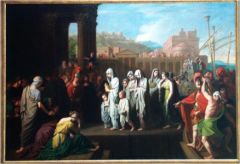
|
"Ashes of Germanicus" by West Neoclassicism 1776-1865 - The first neoclassic painting ever - Avant Garde - ahead of it's time - Germanicus was poisioned and Agrapinia confronts the senate because she believes they killed him |
|
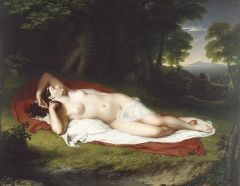
|
"Ariadne Asleep on the Island of Naxos" by Vanderlyn Neoclassicism 1776-1865 - Ariadne was abandoned by Thesus on Naxos after she told him how to capture her father's Minotaur - She is the daugter of King Minos |
|
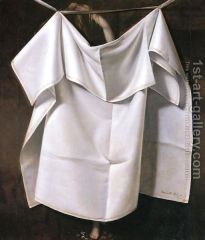
|
"Venus Rising from the Sea" by Peale Neoclassicism 1776-1865 - trompe l'oiel - "Fool the eye" visual deception to make you think you're looking at the real thing - adresses issues of american nudity |
|
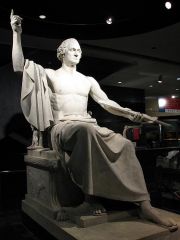
|
"George Washington" by Greenough Neoclassicism 1776-1865 - The 1st federal comissioned sculpture in America - Comissioned for the capital - Made in Italy |
|
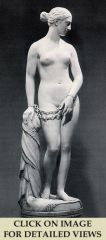
|
"The Greek Slave" by Powers Neoclassicism 1776-1865 - She was a chained prisioner as the result of the greek war of independence. The greeks fought the turks - She has the rosary in her hands which signifies her as a christian woman |
|
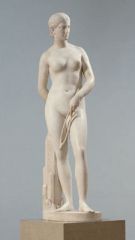
|
"California" by Powers Neoclassicism 1776-1865 - represents the riches of california - Standing against a quartz crystal |
|

|
"The White Captive" by Palmer Neoclassicism 1776-1865 - girl abducted by Indians - was meant to encompass all that is Christianity |
|
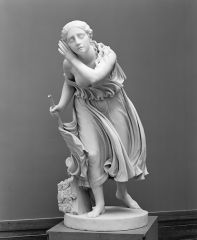
|
"Nydia the Blind Girl of Pompeii" by Rogers Neoclassicism 1776-1865 - She is a completely falsified character that lived in Pompeii - She was the only survivor after the eruption of the volcano |
|
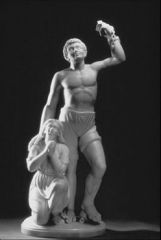
|
"Forever Free" by Lewis Neoclassicism 1776-1865 - Black woman sculptor - First black sculpture and artwork to have a black male as the center subject - Woman might be black but it's not certian |
|
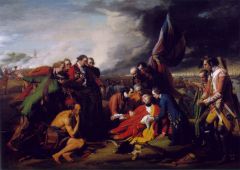
|
"Death of Wolfe" by West Romanticism 1776-1865 - |
|
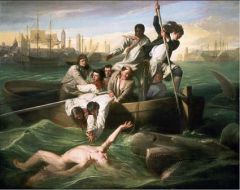
|
"Watson and the Shark" by Copley Romanticism 1776-1865 - Man struggling against the forces of nature = shark - This was copleys 15 minutes of fame, he couldn't sustain his popularity in london as he did in colonial America - people sainted at the sight of this because they thought it was real |
|
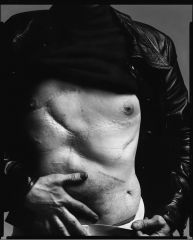
|
"Death and Disaster" by Warhol - Images emphasizing death in America - Scars from surgery after gunshot to his torso by attempted homicide from Valerie Solanas |
|
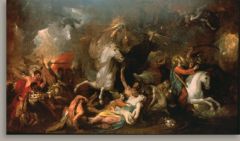
|
"Death on a Pale Horse" by West Romanticism 1776-1865 - People were frightened and thrilled by the horse and they thought they were going to be trampelled because the horse looks posessed - sublime - intense emotions that would bring feelings of closeness to god |
|
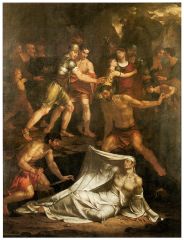
|
"The Dead Man Restored to Life by Touching the Bones of Prophet Elisha" by Allston Romanticism 1776-1865 - Story from the old testament 2nd book of cains - Dramatic and theatrical moment where the dead man is now uncovering himself |
|
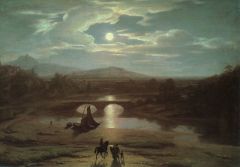
|
"Moonlit Landscape" by Allston Romanticism 1776-1865 - Created in boston - Completely imagined |
|
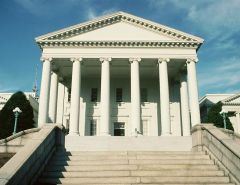
|
"Virginia State Capitol" by Jefferson Neoclassicism 1776-1865 - Jefferson adored roman architecture - Modeled directly from the Maison Caree in Nimes, France - The Maison Caree used corinthian columns, but Jefferson used iconic instead to make the building look more professional |
|
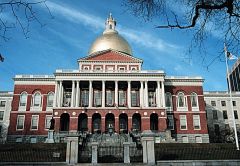
|
"Massachusetts State House" by Bullfinch Neoclassicism 1776-1865 - |
|
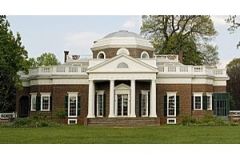
|
"Monticello" by Jefferson Neoclassicism 1776-1865 - |
|
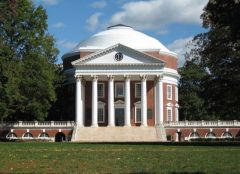
|
"University of Virginia" by Jefferson Neoclassicism 1776-1865 - Most spectacular architectural achievement by Jefferson because of how idealistic it is. - First non-religious publicly funded institution of higher learning - Located in the Blue Ridge Mountains, Jefferson thought that clean air was necessary for good education |
|
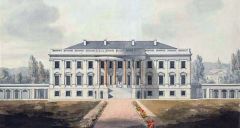
|
"The White House" by Latrobe and Hoban Neoclassicism 1776-1865 - Jefferson entered his design for the White House design competition anoymously so their wouldn't be a biased decision and he lost - British burned the White House in 1812 and Latrobe repaired it |
|
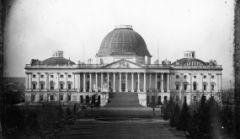
|
"East Front of US Capitol" by Thorton Neoclassicism 1776-1865 - Open competition to design it - Connection between roman tradition, democracy, and the architecture |
|
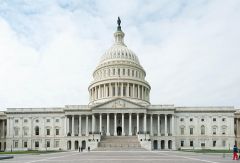
|
"US Capitol" by Latrobe and Bulfinch Neoclassicism 1776-1865 - They tightened up Thorton's design, added a staircase, and emphasized corinthian columns - Bulfinch added the domes on the side buildings and adjusted the center dome to make it more bulbous. |
|

|
"US Capitol" by Walter Neoclassicism 1776-1865 - Built over the years of the civil war and became a symbol for union and the idea that "bigger is better" - Influenced by St. Paul's Cathedral by Michelangelo in Rome |
|

|
"Second Bank of the US" by Strickland Neoclassicism 1776-1865 - Philly based architect - Was a federal bank, had a short life as it was never recharted by Andrew Jackson - Had an enormous influence on the design of banks in America |
|
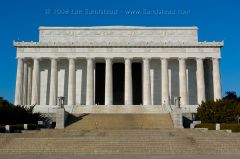
|
"Lincoln Memorial" by Bacon Neoclassicism 1776-1865 - Greek architecture contained dieties inside of them to which the temples were dedicated - Lincoln is paralleled to a diety - Parthenon design similarites |
|

|
"Henry Delamater Residence" by Davis Romanticism 1776-1865 - Board and Batten wooden frame which is wide vertical wooden planks with think wood strips covering the seams - Front porch puts the family on display to the neighborhood to show off all their leisure time |
|
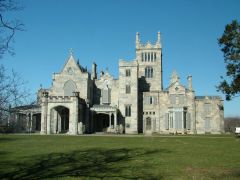
|
"Lyndhurst" by Davis Romanticism 1776-1865 - Looks similar to gothic style architecture - Uses asymmetry and casement windows - Private home located on the Hudson River |
|

|
"Cottage Residences" by Downing Romanticism 1776-1865 - A book written by Downing that was a must have for middle class americans - It was the martha stewart of its time |
|
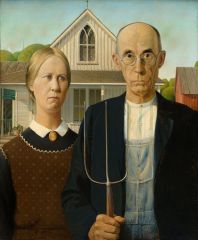
|
"American Gothic" by Wood Romanticism 1776-1865 - Wood's dentist is the model for the man with the pitchfork, Wood's sister is the model for the woman. -Reminiscent of "the good old days" of farm life before the depression - House in the background is now a landmark in Iowa |
|
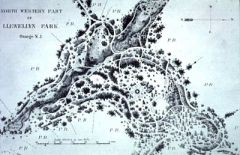
|
"Llewellyn Park" by Davis Romanticism 1776-1865 - First planned residential non-religious community in America - Located in Essex county, NJ - Gated community till this day |
|
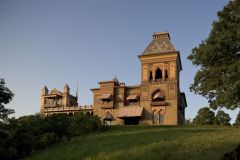
|
"Olana" by Vaux and Church Romanticism 1776-1865" - Church's art studio and his home - Remained in the family until 1964, nothing removed from the house until that time -Olana means our place on high by Arabic |
|
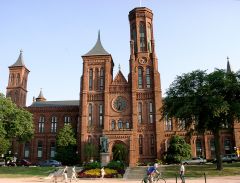
|
"Smithsonian Insitution" by Renwick Romanticism 1776-1865 - Largest building in America in the Romantic style - Stands out from the neoclassical designs in DC that are symmetrical, white, and greek temple like. - Uses a brown color with asymmetry, looks like a church. |
|
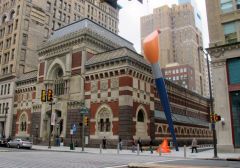
|
"Pennsylvania Academy of the Fine Arts" by Furness and Hewitt Romanticism 1776-1865 - Rebuilt in the more fashionable part of town - Student enterance is on the side of the building, front enterance is for the rich people to visit the museum - Animal carcuses were delivered to a shoot near the front door |
|
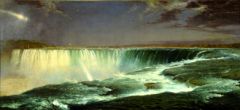
|
"Niagra" by Church Hudson River School 1820-1865 - Rainbow represents God - There are no people in this painting regardless of the fact that this is the number one tourist destination at the time. Emphasis NOT on realism. |
|
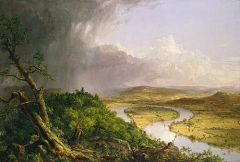
|
"The Oxbow" by Cole Hudson River School 1820-1865 - Cole embedded in the lush growth of the landscape. He is in the painting, which is not what students did, they sketched. - two types of nature/landscapes. 1. man altered and 2. natural lush |
|
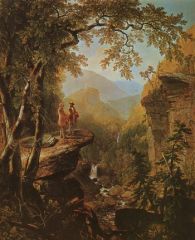
|
"Kindred Spirits" by Durand Hudson River School 1820-1865 - Painted a year after Cole's death - two men are Cole and William who are united in their love for nature - Three trees symbolize trinity - God and nature are one in the same
|
|

|
"Blue Hole, Little Miami River" by Duncanson Hudson River School 1820-1865 - Duncanson was an african american painter, well supported by the public - x like configuration - painting created from sketches |
|
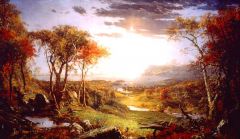
|
" Autumn on the Hudson River" by Cropsey Hudson River School 1820-1865 - After the 1850's, artists have access to collapsible tubes of paint. Prior they had to mix their own colors. - Reds, Yellows, Oranges, and Purples are much more brilliant now because of teh tubes - British thought this was fake because of the colors of the fall leaves. Cropsey sent the queen a leaf as proof |
|
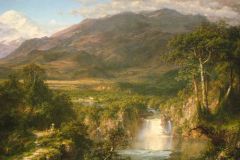
|
"The Heart of the Andes" by Cropsey Hudson River School 1820-1865 - based on 2 tripes made to the Andes in South America - Artist's signature is painted so that it's a carving in the tree trunk on the left side of the painting |
|
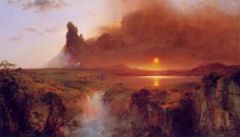
|
"Cotopaxi" by Church Hudson River School 1820-1865 - volcano located in Ecuador - Never actually saw cotopaxi or it erupting |
|
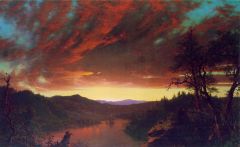
|
"Twilight in the Wilderness" by Church Hudson River School 1820-1865 - Thoreau commented that sunsets are paintings by God the great artist - Adirondack mountains in NY
|
|
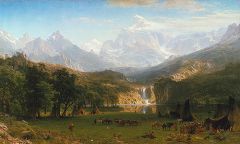
|
"The Rocky Mountians, Lander's Peak" by Bierstadt Hudson River School 1820-1865 - set in Wyoming, he saw the actual scene it's not from imagination - palladian mode - small scale figures in foreground, central water, light background, dark foreground, mountians in background, trees frame |
|
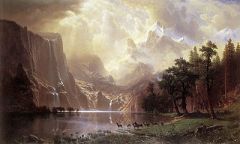
|
"Among the Sierra Nevada Mountains" Bierstadt Hudson River School 1820-1865 - reinforced the idea of biblical creation - concern to preserve the western landscape after seeing what happened to the east |
|
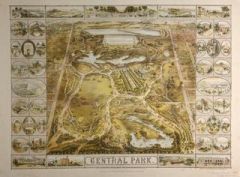
|
"Central Park" by Olmstead and Vaux Romantic Landscape Design 1776-1865 - Necessary for the health and mental improvement of the public - Democratic landscape regardless of race, religion, creed or income |
|
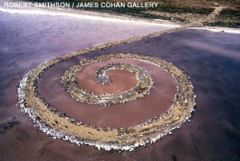
|
"Spiral Jetty" by Smithson Romantic Landscape Design 1776-1865 -EARTHWORK - Site specific, made specifically for this spot - originally an oil drill site, smithson feels he was doing rehab on the site by building the spiral |
|
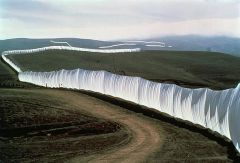
|
"Running Fence" by Christo and Jeanne Claude Romantic Landscape Design 1776-1865 - Existince was limited, lasted for 2 weeks, made the viewers experience the present - Went through 59 private ranches, crosses state and county roads, and went through a town. needed premission from these places before building |
|
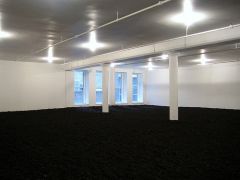
|
"New York Earth Room" by DeMaria Romantic Landscape Design 1776-1865 - "Earth" as opposed to dirt becaues dirt has a negative connotation - Earth protected indoors like it's a holy relic - white room and no flowers allows the focus to be on the earth |
|
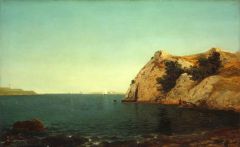
|
"Beacon Rock, Newport Harbor" by Kensett Luminism 1850-1875 - |
|
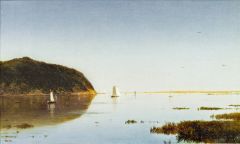
|
"Shrewsbury River" by Kensett Luminism 1850-1875 - stong emphasis on water and light - still water creates an eerie quietness |
|

|
"Owl's Head, Penobscot Bay" by Lane Luminism 1850-1875 - |
|

|
"Brace Rock" by Lane Luminism 1850-1875 - No sense of a human presence - boat is decaying suggesting a passing of time |
|
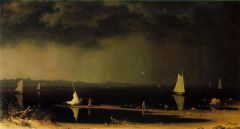
|
"Thunder Storm on Narragansett Bay" by Heade Luminism 1850-1875 - Found inside a thrift shop - Dark heavy clouds cast a shadow onto the water - Fence on left looks like a cross |
|
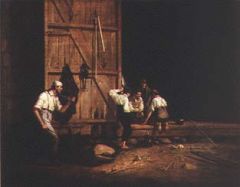
|
"The Truant Gambler" by Mount Romanticism 1776-1865 - Genre painting - Children gambling and man coming in to bust them |
|
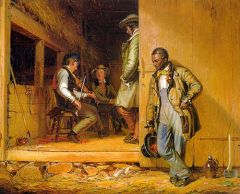
|
"The Power of Music" by Mount Romanticism 1776-1865 - Genre painting - barn door divides the foreground with background and creates two seperate scenes and represent a racial divide - racist moonshine and tattered clothing, others think he's liberal for putting a black man depictied so honestly into his painting
|
|

|
"Eel Spearing at Setauket" by Mount Romanticism 1776-1865 - Black woman adds visual interest to wealthy white who would buy this painting - having a black man would have been too abrasive |
|

|
"Fur Traders Descending the Missouri" by Bingham Romanticism 1776-1865 - Was named the "Fur trapper and half breed son" but it was renamed - Animal possibly linked to his interest in the occult, we are unsure of what animal it is exactly |
|
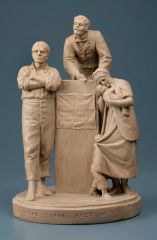
|
"Slave Auction" by Rogers Romanticism 1776-1865 - Made from a plaster mold so it could be mass produced - Painted grey or beige to suggest it's made of more expensive stone |
|
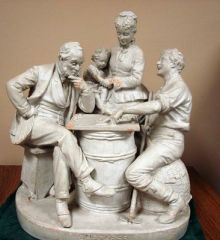
|
"Checkers Up at the Farm" Rogers Romanticism 1776-1865 - Wife and child are helping with the game moves, baby's foot is nudging the pieces over, adds humor to the genre composition |
|
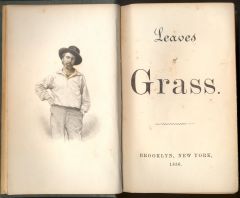
|
"Leaves of Grass" by Whitman Realism 1865-1900 |
|
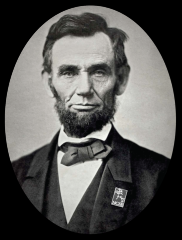
|
"Mr. Lincoln's Camera Man" by Brandy Realism 1865-1900 |
|
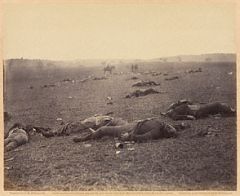
|
"A Harvest of Death" by O'Sullivan Realism 1865-1900 - visited gettysburg and took this photograph - picking the pockets of dead people - harvest |
|
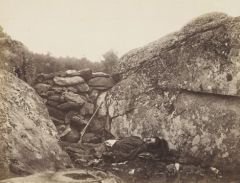
|
"Home of the Rebel Sharpshooter" by Gardner Realism 1865-1900 - Taken on the Gettysburg battlefield - part of the "Gardner Photographic Sketchbook of War" - There's a dead body laying in the ditch, moved by gardner, with a gun propped up, to add narrative. |
|
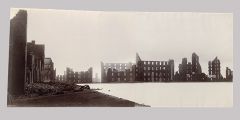
|
"Ruins of the Flour Mills" by Gardner Realism 1865-1900 - Part of Gardner's Photographic Sketchbook of the War - Was the capitol of the confederacy - burned out so there would be no trace of prosperity found by the british |
|
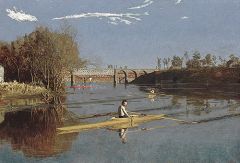
|
"Max Schmitt in a Single Scull" by Eakins Realism 1865-1900 - the landscape was painted on site - the man in the front scull is Max Schmitt, Eakin's friend. he is in the one in the background - Comination portrait and Genre scene
|
|
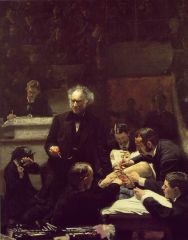
|
"The Gross Clinic" by Eakins Realism 1865-1900 - Honors Philly surgeon Dr. Gross - Child paitent having a diseased bone removed from his thigh - Mother is to the left cowarding away - Light from above is the skylight which was typical and necessary for surgery - Recieved negatively by the community, thought it wasn't artful |
|
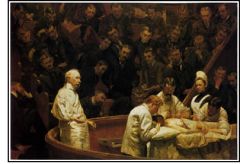
|
"The Agnew Clinic" by Eakins Realism 1865-1900 - Surgery being performed is a masectomy - Dr Agnew liked to instruct students by initially performing the surgery then stepping back to lecture - Nurse is a UPenn student wearing the traditiona uniform - Eakins on the right of the painting - Men in the crowd have their heads on one another |
|
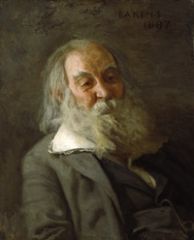
|
"Walt Whitman" by Eakins Realism 1865-1900 |
|

|
"Animal Locomotion" by Muybridge Realism 1865-1900 - photograph showing movement |
|
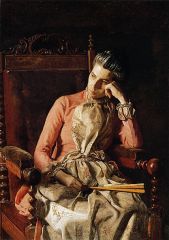
|
"Miss Amelia van Buren" by Eakins Realism 1865-1900 - Interesting parallels between this and Copley - women seem thoughtful, lighting coming from the upper left, nothing behind the woman, seated in similar positions, hand on head. Eakins has a more realistic style |
|
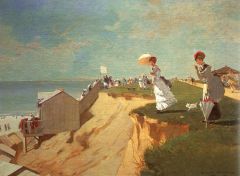
|
"Long Branch, NJ" by Homer Realism 1865-1900 - Strongly influenced by popular Japanese prints he loved - Very light filled and airy, suggests that Homer saw impressionism in Paris although we are unfamiliar with his work while he lived there |
|
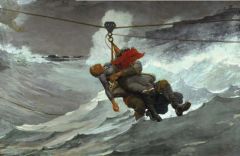
|
"The Life Line" by Homer Realism 1865-1900 - Homer saw lifesaving techniques in Atlantic City - Figure being brought in from a shipwreck on a life saing cable by a rescuer who's face is being blocked by a red scarf |
|
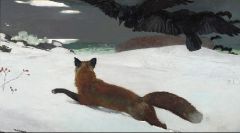
|
"Foxhunt" by Homer Realism 1865-1900 - Painted while he lived in Maine - Flocks of birds attempting to attack the fox who is having trouble navigating because of the snow - Has a flat, Japanese styled quality. there is no dimension in the fox's body -Letters of homer's name painted so they seem to be seeping into the snow |
|
|
. |
The Armory Show - 69th Regiment Armory in NYC International Exhibition of Modern Art - around 1600 works by 300 artists - people didn't get it! they showed up because they thought it was funny! - this was the first divide between art culture and popular culture |

